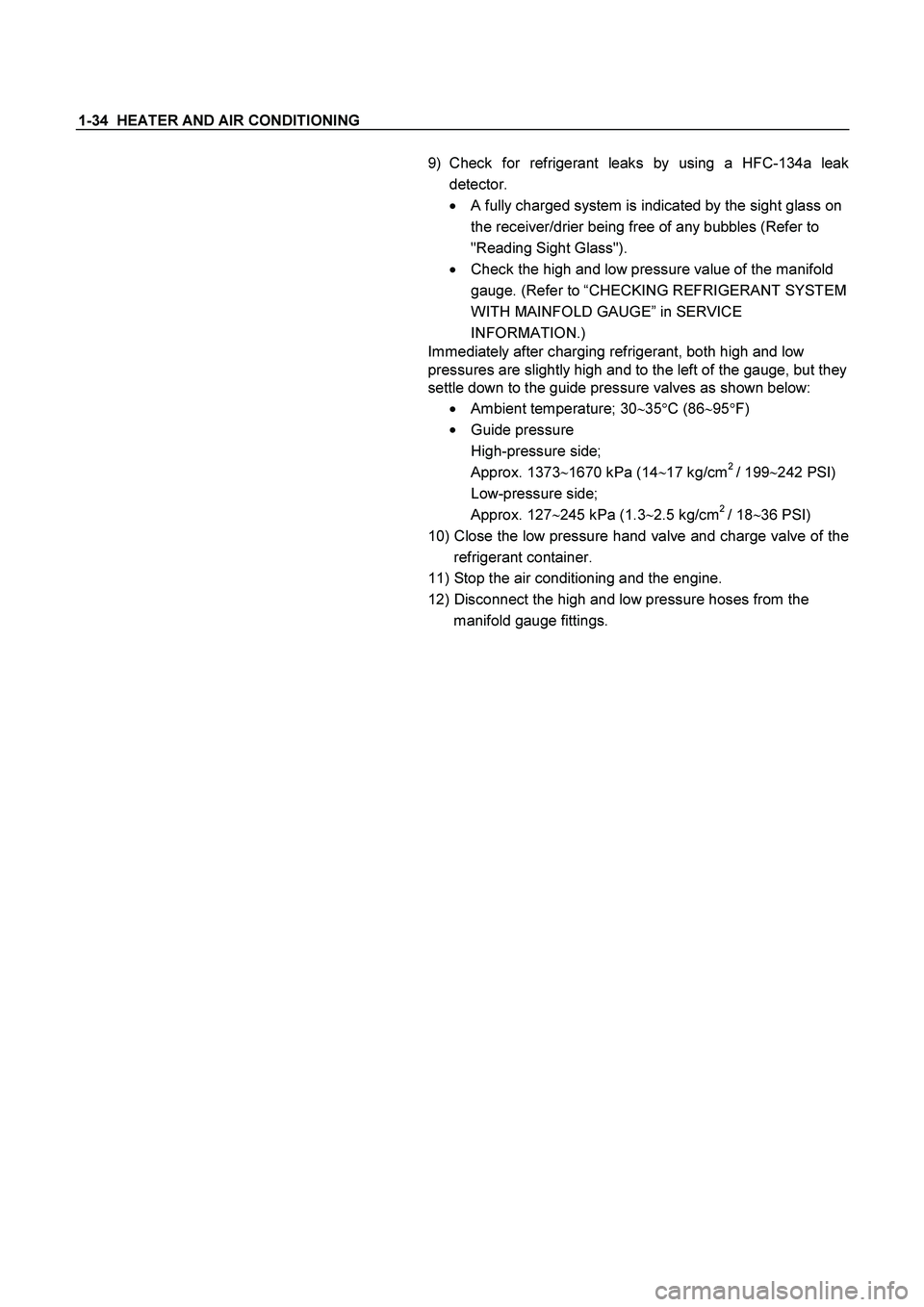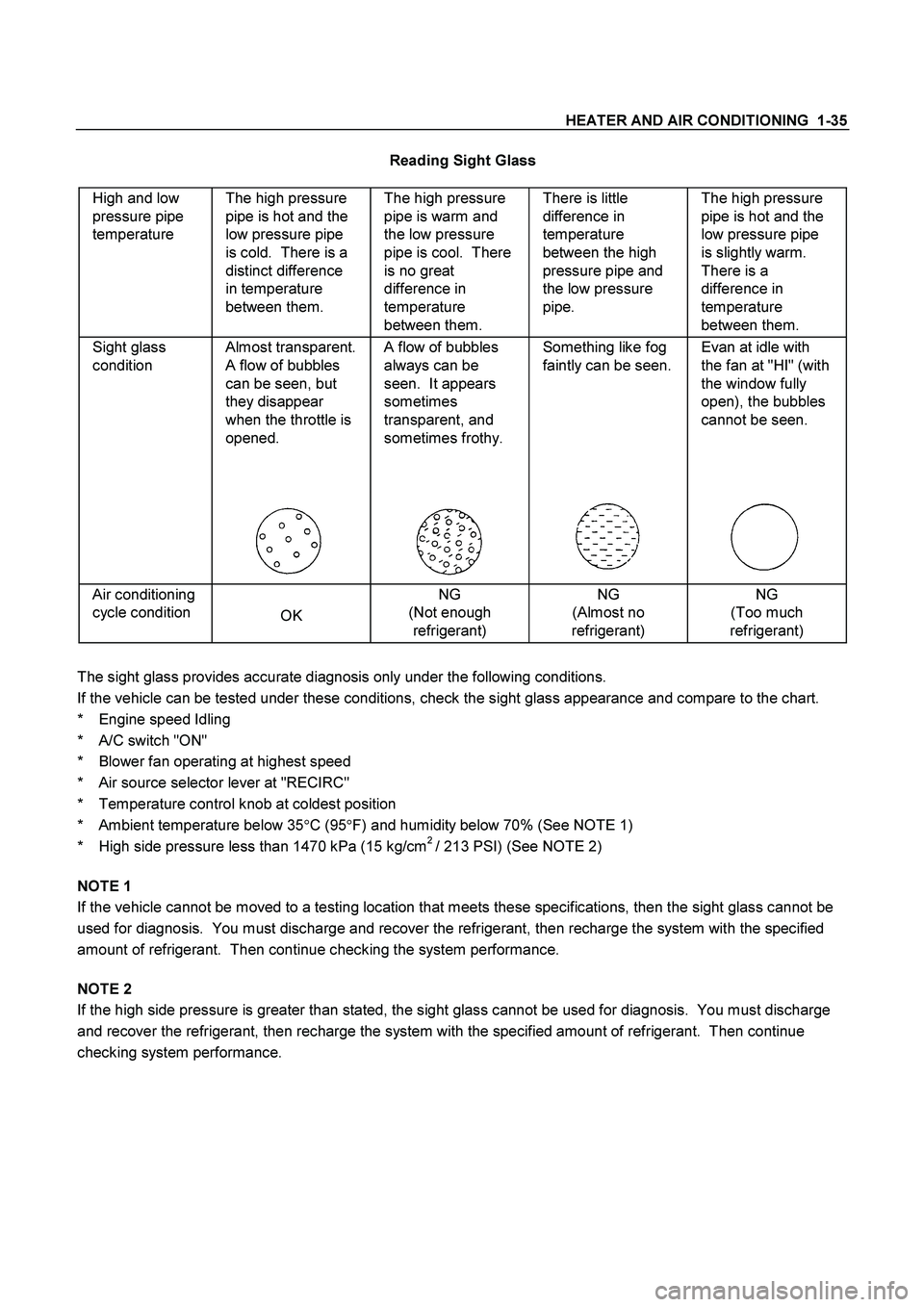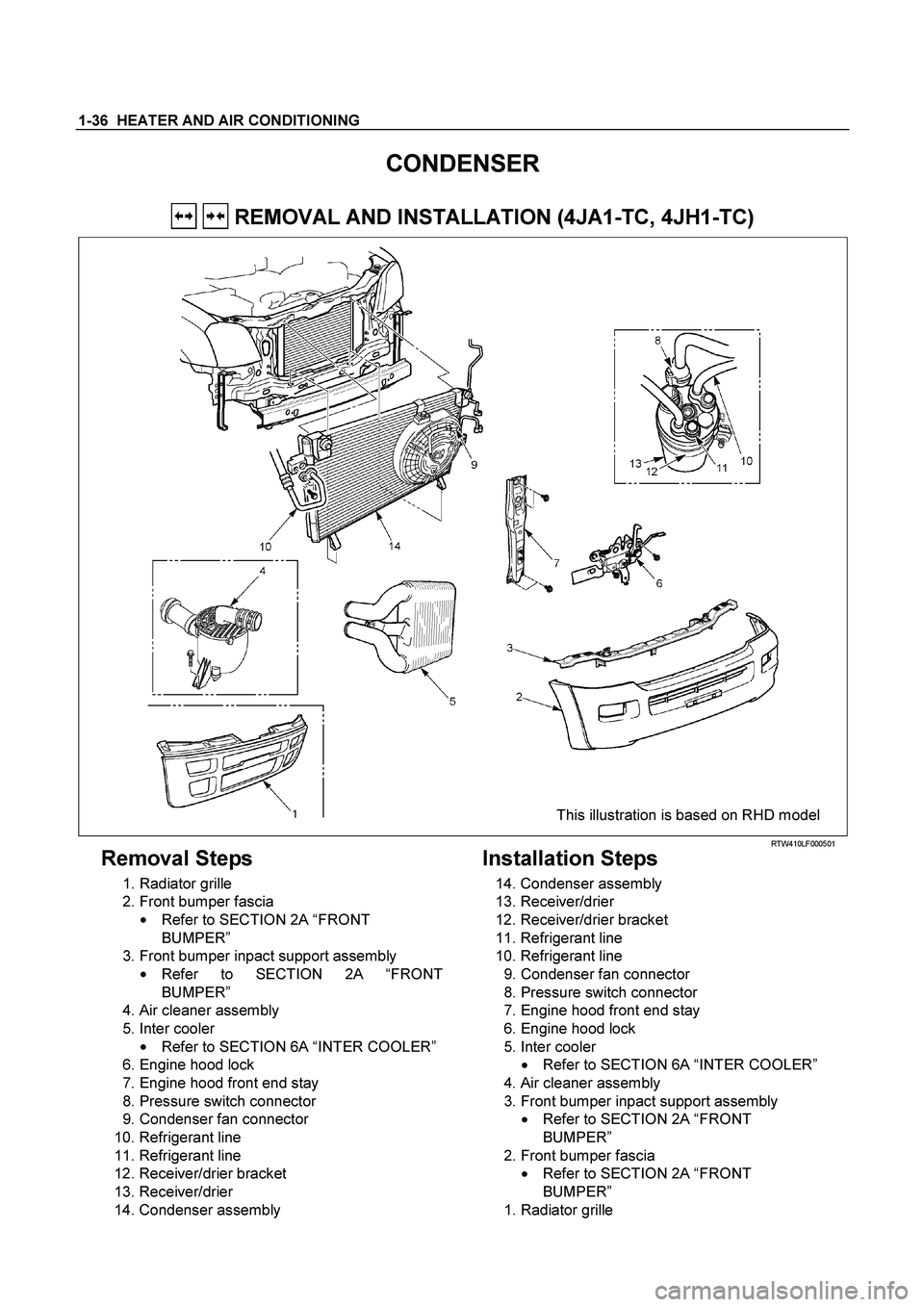Page 3044 of 4264

1-34 HEATER AND AIR CONDITIONING
9) Check for refrigerant leaks by using a HFC-134a leak
detector.
�
A fully charged system is indicated by the sight glass on
the receiver/drier being free of any bubbles (Refer to
"Reading Sight Glass").
�
Check the high and low pressure value of the manifold
gauge. (Refer to “CHECKING REFRIGERANT SYSTEM
WITH MAINFOLD GAUGE” in SERVICE
INFORMATION.)
Immediately after charging refrigerant, both high and low
pressures are slightly high and to the left of the gauge, but they
settle down to the guide pressure valves as shown below:
� Ambient temperature; 30�35�C (86�95�F)
�
Guide pressure
High-pressure side;
Approx. 1373�
1670 kPa (14�
17 kg/cm
2 / 199�
242 PSI)
Low-pressure side;
Approx. 127�
245 kPa (1.3�
2.5 kg/cm
2 / 18�
36 PSI)
10) Close the low pressure hand valve and charge valve of the
refrigerant container.
11) Stop the air conditioning and the engine.
12) Disconnect the high and low pressure hoses from the
manifold gauge fittings.
Page 3045 of 4264

HEATER AND AIR CONDITIONING 1-35
Reading Sight Glass
High and low
pressure pipe
temperature The high pressure
pipe is hot and the
low pressure pipe
is cold. There is a
distinct difference
in temperature
between them. The high pressure
pipe is warm and
the low pressure
pipe is cool. There
is no great
difference in
temperature
between them. There is little
difference in
temperature
between the high
pressure pipe and
the low pressure
pipe. The high pressure
pipe is hot and the
low pressure pipe
is slightly warm.
There is a
difference in
temperature
between them.
Sight glass
condition Almost transparent.
A flow of bubbles
can be seen, but
they disappear
when the throttle is
opened.
A flow of bubbles
always can be
seen. It appears
sometimes
transparent, and
sometimes frothy.
Something like fog
faintly can be seen.
Evan at idle with
the fan at "HI" (with
the window fully
open), the bubbles
cannot be seen.
Air conditioning
cycle condition
OK NG
(Not enough
refrigerant) NG
(Almost no
refrigerant) NG
(Too much
refrigerant)
The sight glass provides accurate diagnosis only under the following conditions.
If the vehicle can be tested under these conditions, check the sight glass appearance and compare to the chart.
* Engine speed Idling
* A/C switch "ON"
* Blower fan operating at highest speed
* Air source selector lever at "RECIRC"
* Temperature control knob at coldest position
* Ambient temperature below 35�
C (95�
F) and humidity below 70% (See NOTE 1)
* High side pressure less than 1470 kPa (15 kg/cm
2 / 213 PSI) (See NOTE 2)
NOTE 1
If the vehicle cannot be moved to a testing location that meets these specifications, then the sight glass cannot be
used for diagnosis. You must discharge and recover the refrigerant, then recharge the system with the specified
amount of refrigerant. Then continue checking the system performance.
NOTE 2
If the high side pressure is greater than stated, the sight glass cannot be used for diagnosis. You must discharge
and recover the refrigerant, then recharge the system with the specified amount of refrigerant. Then continue
checking system performance.
Page 3046 of 4264

1-36 HEATER AND AIR CONDITIONING
CONDENSER
REMOVAL AND INSTALLATION (4JA1-TC, 4JH1-TC)
This illustration is based on RHD model RTW410LF000501
Removal Steps
1. Radiator grille
2. Front bumper fascia
�
Refer to SECTION 2A “FRONT
BUMPER”
3. Front bumper inpact support assembly
�
Refer to SECTION 2A “FRONT
BUMPER”
4. Air cleaner assembly
5. Inter cooler
�
Refer to SECTION 6A “INTER COOLER”
6. Engine hood lock
7. Engine hood front end stay
8. Pressure switch connector
9. Condenser fan connector
10. Refrigerant line
11. Refrigerant line
12. Receiver/drier bracket
13. Receiver/drier
14. Condenser assembly
Installation Steps
14. Condenser assembly
13. Receiver/drier
12. Receiver/drier bracket
11. Refrigerant line
10. Refrigerant line
9. Condenser fan connector
8. Pressure switch connector
7. Engine hood front end stay
6. Engine hood lock
5. Inter cooler
�
Refer to SECTION 6A “INTER COOLER”
4. Air cleaner assembly
3. Front bumper inpact support assembly
�
Refer to SECTION 2A “FRONT
BUMPER”
2. Front bumper fascia
�
Refer to SECTION 2A “FRONT
BUMPER”
1. Radiator grille
Page 3047 of 4264
HEATER AND AIR CONDITIONING 1-37
REMOVAL AND INSTALLATION (EXCEPT 4JA1-TC, 4JH1-TC)
RTW410LF000701
Removal Steps
1. Radiator grille
2. Engine hood lock
3. Engine hood front end stay
4. Pressure switch connector
5. Condenser fan connector
6. Refrigerant line
7. Refrigerant line
8. Receiver/drier bracket
9. Receiver/drier
10. Condenser assembly
Installation Steps
10. Condenser assembly
9. Receiver/drier
8. Receiver/drier bracket
7. Refrigerant line
6. Refrigerant line
5. Condenser fan connector
4. Pressure switch connector
3. Engine hood front end stay
2. Engine hood lock
1. Radiator grille
Page 3048 of 4264
1-38 HEATER AND AIR CONDITIONING
CONDENSER FAN MOTOR
REMOVAL AND INSTALLATION
RTW410MF000101
Removal Steps
1. Radiator grille
2. Fan connector
3. Condenser fan motor
Installation Steps
3. Condenser fan motor
2. Fan connector
1. Radiator grille
Page 3049 of 4264
HEATER AND AIR CONDITIONING 1-39
RECEIVER / DRIER
REMOVAL AND INSTALLATION
RTW410LF000601
Removal Steps
1. Radiator grille
2. Trinary pressure switch connector
3. Refrigerant line
4. Bracket bolt
5. Receiver/drier
Installation Steps
5. Receiver/drier
4. Bracket bolt
3. Refrigerant line
2. Trinary pressure switch connector
1. Radiator grille
Page 3050 of 4264
1-40 HEATER AND AIR CONDITIONING
COMPRESSOR
REMOVAL AND INSTALLATION (4J ENGINE)
852R300006
Removal Steps
1. Air duct
2. Magnetic clutch harness connector
3. Lock nut
4. Tension adjustment bolt
5. Drive belt
6. Refrigerant line
7. Bolt; compressor to bracket
8. Compressor assembly
Installation Steps
8. Compressor assembly
� 7. Bolt; compressor to bracket
� 6. Refrigerant line
5. Drive belt
4. Tension adjustment bolt
3. Lock nut
2. Magnetic clutch harness connector
1. Air duct
Page 3051 of 4264
HEATER AND AIR CONDITIONING 1-41
Important Operations - Installation
7. Bolt; Compressor to Bracket
N�m (kgf�m/lb�ft)
Torque 44 (4.5/33)
6. Refrigerant Line
N�m (kgf�m/lb�ft)
Torque 11�19 (1.1/9.5�1.9/14)
Compressor Belt
Check the drive belt tension.
Depress the drive belt mid-portion with a 98N (10kg/22Ib)
force.
mm(in.)
Standard deflection 14~17 (0.55~0.67)